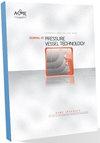半开阀水锤实验异常分析
IF 1.4
4区 工程技术
Q4 ENGINEERING, MECHANICAL
Journal of Pressure Vessel Technology-Transactions of the Asme
Pub Date : 2022-08-26
DOI:10.1115/1.4055380
引用次数: 0
摘要
在本研究中,对部分打开的阀门突然关闭引起的水锤压力进行了实验和分析研究。由于部分开启的阀门会产生局部非均匀流动,基于局部非均匀流的假设和动能方程,导出了补充的Joukowsky水锤方程。建立了一个物理模型,测量了在不同水头、流速、管径和阀门类型的条件下,由于部分开启的阀门突然关闭而引起的第一次正波的最大水锤压力。结果表明,由均匀流场中的动量定理得到的Joukowsky方程适用于阀门全开的均匀流场。部分开启阀关闭水锤压力的实验结果比Joukowsky方程大3.5%~21%,这与补充Joukowski水锤方程的理论分析相一致。这种现象具有重复性,与水头、进水流速、管径和阀门类型无关。该研究可为水电站和泵站的水锤防护提供指导。本文章由计算机程序翻译,如有差异,请以英文原文为准。
Analysis of Anomalies in Water-Hammer Experiments with Partially-Open Valves
In this study, the water hammer pressure due to the sudden closure of the partially-open valve was investigated experimentally and analytically. Because the partially-open valve could produce local non-uniform flow, a supplementary Joukowsky's water hammer equation was derived based on the assumption of the local non-uniform flow and the kinetic energy equation. A physical model was set up to measure the maximum water hammer pressure of the first positive wave due to the sudden closure of partially-open valve under different conditions, including different water heads, flow velocities, pipe diameters and valve types. The results showed that Joukowsky's equation obtained by the momentum theorem in the uniform flow field was applicable to the uniform flow field with the valve fully open. The experimental results of the partially-open valve-closure water hammer pressure were 3.5%~21% larger than Joukowsky's equation, which consisted with the theoretical analysis of the supplementary Joukowsky's water hammer equation. This phenomenon had repeatability and was unrelated with the water head, the inlet flow velocity, the pipe diameter and the valve type. This study could provide guidance for water hammer protection in hydropower stations and pump stations.
求助全文
通过发布文献求助,成功后即可免费获取论文全文。
去求助
来源期刊
CiteScore
2.10
自引率
10.00%
发文量
77
审稿时长
4.2 months
期刊介绍:
The Journal of Pressure Vessel Technology is the premier publication for the highest-quality research and interpretive reports on the design, analysis, materials, fabrication, construction, inspection, operation, and failure prevention of pressure vessels, piping, pipelines, power and heating boilers, heat exchangers, reaction vessels, pumps, valves, and other pressure and temperature-bearing components, as well as the nondestructive evaluation of critical components in mechanical engineering applications. Not only does the Journal cover all topics dealing with the design and analysis of pressure vessels, piping, and components, but it also contains discussions of their related codes and standards.
Applicable pressure technology areas of interest include: Dynamic and seismic analysis; Equipment qualification; Fabrication; Welding processes and integrity; Operation of vessels and piping; Fatigue and fracture prediction; Finite and boundary element methods; Fluid-structure interaction; High pressure engineering; Elevated temperature analysis and design; Inelastic analysis; Life extension; Lifeline earthquake engineering; PVP materials and their property databases; NDE; safety and reliability; Verification and qualification of software.

 求助内容:
求助内容: 应助结果提醒方式:
应助结果提醒方式:


